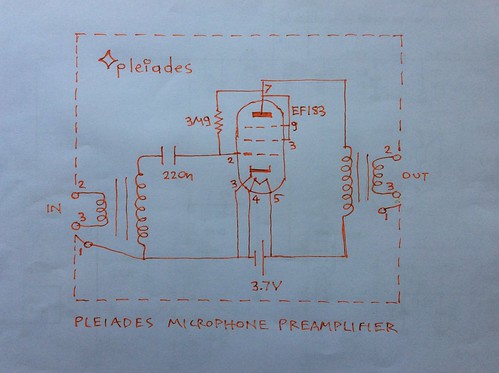At your risk. A suitable fuse must be used in series with voltage sources, eg batteries for safety.
These are direct heated, filament electron tube triode with relatively high filament current, typically 120mA. It would be less if they are underheated.
5676
https://frank.pocnet.net/sheets/127/5/5676.pdf
CK6286
https://frank.pocnet.net/sheets/138/6/6286.pdf
Would they operate as mic booster amplifiers etc with 1.3V at anode too, on the Pleiades V6 schematic?

So far from electron tubes that have been tried, the CV2269 electrometer tube RC coupled to output (Pleiades V1), the EF183 triode connected and Nuvistor 7586 could operate at only 1.3V at anode or plate with pull up,bias instead of to positive cathode to positive anode. (Cathode is positive with respect to to grid as it is editing ie loosing electrons) by thermionic emission. See previous posts.
By looking at the Raytheon datasheet:...
Industrial and military cathode subminiature tubes - Raytheon - technicalaudio.com
http://www.technicalaudio.com/pdf/Raytheon/Raytheon_Cathode_Subminiature_Tubes.pdf
Also 5904 at higher heater voltage, not much more than 12V, would these be suitble for grid at space potential operation with plate voltage around 12V?
https://frank.pocnet.net/sheets/137/5/5904.pdf
Also 5004 to 5908B.
7760 similarly.
6321, 6.3V heater, low heater current, low μ which seems better for low plate voltage operation, see previous posts.
6320 6.3V heater, low heater current, double triode high μ
6948 6.3V much lower heater current.
Heaters can be underheated anyway for low plate voltage operation. See previous posts.
How about hearing aid tubes? They only consume typically 10mA at heater filament or cathode.
For example DF64, DF651, DF67, CK549DX, DL64, DL67, CK548DX.
Later addition:
Another 1.25V heater filament cathode voltage tetrode electron tube at 50mA filament current is 5678 or CK5678:
https://frank.pocnet.net/sheets/138/5/5678.pdf
By looking at the datasheet for triode connection, it should possibly operate will only 1.3V at the plate, anode with pull up bias from grid to anode or Vb.
But for the moment at least let's concentrate on Nuvistor 2DV4 which might operate with 1.3V for both heaters and plate with pull up bias to anode.








